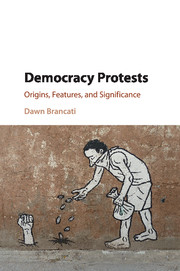Book contents
- Frontmatter
- Dedication
- Contents
- List of Figures
- List of Tables
- Acknowledgments
- 1 Introduction
- 2 Characteristics of Democracy Protests
- 3 Relating Economic Crises to Democracy
- 4 Analyzing the Rise of Democracy Protests
- 5 Analyzing Elections as Trigger Events
- 6 Historical Trends in Government Responses
- 7 Analyzing Political Accommodation
- 8 Historical Trends in Democratization
- 9 Analyzing Democratization
- 10 Conclusion
- Appendix: Data and Measures
- References
- Index
6 - Historical Trends in Government Responses
Published online by Cambridge University Press: 05 September 2016
- Frontmatter
- Dedication
- Contents
- List of Figures
- List of Tables
- Acknowledgments
- 1 Introduction
- 2 Characteristics of Democracy Protests
- 3 Relating Economic Crises to Democracy
- 4 Analyzing the Rise of Democracy Protests
- 5 Analyzing Elections as Trigger Events
- 6 Historical Trends in Government Responses
- 7 Analyzing Political Accommodation
- 8 Historical Trends in Democratization
- 9 Analyzing Democratization
- 10 Conclusion
- Appendix: Data and Measures
- References
- Index
Summary
In the post–Cold War period, governments ignored democracy protests almost as often as they accommodated them, but violent repression was by far the most common response. Between 1989 and 2011, governments violently repressed two-thirds of all democracy protests that occurred in this period using either military or police force and nonviolently repressed approximately one-third of them. (See Figure 6.1.) Governments made concessions to slightly less than a quarter of all democracy protests in this period, and in two-thirds of these cases, governments only made these concessions after first trying to repress the protests through either violent or nonviolent means. In this chapter, I examine how governments respond to democracy protests in detail, as well as the conditions surrounding these responses, in order to inform the subsequent statistical analysis of government responses to democracy protests.
ACCOMMODATION
When governments accommodated democracy protests in the post–Cold War period, they did so through either political, economic, or policy concessions. Economic and policy concessions were less common than political concessions, always occurred alongside the latter, and included among other things, promises to improve living standards, create public sector employment, reduce corruption, and so forth. Only concessions on political matters had the potential to affect the structure of regimes. These concessions ranged from modest reforms to eliminate electoral fraud in particular districts to more significant reforms to establish or restore suspended elections. (See Figure 6.2).
Electoral Competitiveness
Political concessions to increase the openness and competitiveness of national elections were the most common type of political reforms governments made in response to democracy protests in the post–Cold War period and the second most common demand of the protests. Reforms targeting the competitiveness of elections generally included legalizing opposition parties, permitting multiparty elections for national offices, and lifting bans on particular political parties or candidates. (See Table 6.1.) In one case, Zimbabwe (1990), the government did not lift an existing ban on the opposition, but decided in response to the protests not to impose a ban on opposition parties. No government in this period was willing to extend the vote to excluded groups, as protesters in the early 1990s demanded for women in Kuwait and foreigners in the Ivory Coast and Zambia. Reforms to expand the right to vote were limited to initiatives to extend voter registration periods and facilitate voter registration in other ways.
- Type
- Chapter
- Information
- Democracy ProtestsOrigins, Features, and Significance, pp. 107 - 126Publisher: Cambridge University PressPrint publication year: 2016



